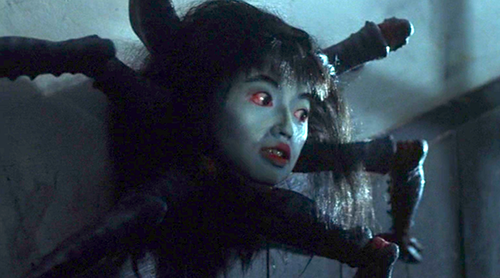
 After you’ve given world cinema a robotic penis drill, what’s left? For Shinya Tsukamoto, the answer had zip to do with terrifying genitalia and everything to do with spritzing neck stumps, poltergeist kitchenware and singing disembodied heads — among other, spindly legged things — in Hiruko the Goblin.
After you’ve given world cinema a robotic penis drill, what’s left? For Shinya Tsukamoto, the answer had zip to do with terrifying genitalia and everything to do with spritzing neck stumps, poltergeist kitchenware and singing disembodied heads — among other, spindly legged things — in Hiruko the Goblin.
Based on a manga by Daijirô Morohoshi, Tsukamoto’s first post-Tetsuo: The Iron Man project concerns famous archeologist Hieda (Kenji Sawada, Samurai Reincarnation), grieving his wife’s accidental death. When a colleague contacts him with news of discovering an ancient burial tomb on the grounds of a school and said to appease evil spirits, Hieda suddenly regains purpose — not to mention a questionable slapsticky presence.
Needing the type of distraction only an invisible demon can provide, Hieda investigates with the chance assistance of the school custodian (Hideo Murota, Akira Kurosawa’s Kagemusha) and a student (Masaki Kudou, Tokyo Heaven). The teen knows a thing or two about curses, as his back occasionally smokes ’n’ sizzles — like a fresh package of Hormel Black Label bacon on an oily griddle, but with crispy faces emerging from the burnt meat.
Hiruko would be unmemorable if not for its creep du grace taking hold at halftime: human-headed spiders. Who cares if they’re a pair of legs short? Arachnophobes are guaranteed at least one serving of the heebie-jeebies as these unholy creatures skitter about, crawl up walls and — shudder — leap toward our heroes. All done with models, the spiders give Tsukamoto a stronger tool for conjuring horror than the film’s dull, drawn-out first block, which lifts the frantic-cartoon tricks from early Sam Raimi.
A senseless but gonzo adaptation (and/or approximation), Hirkuo the Goblin is reminiscent of Kiyoshi Kurosawa’s Sweet Home, with Tsukamoto having a slight edge in creativity and, of course, a surfeit of industrial steam-engine sounds. His movie feels like a dream, (in)complete with the gaps of logic that function as connective tissue, lending an additional layer of discomfort and otherworldliness. —Rod Lott

